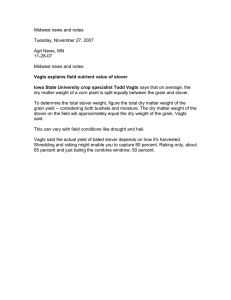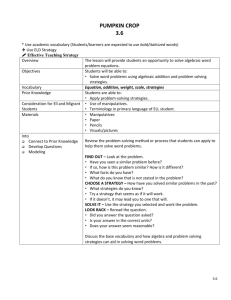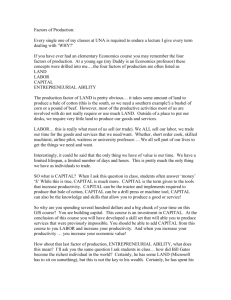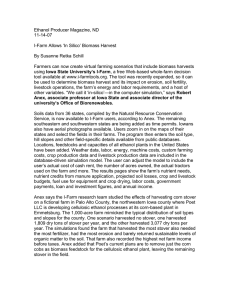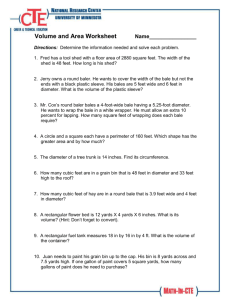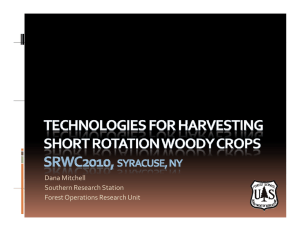C Estimating a Value for Corn Stover File A1-70 June 2014
advertisement
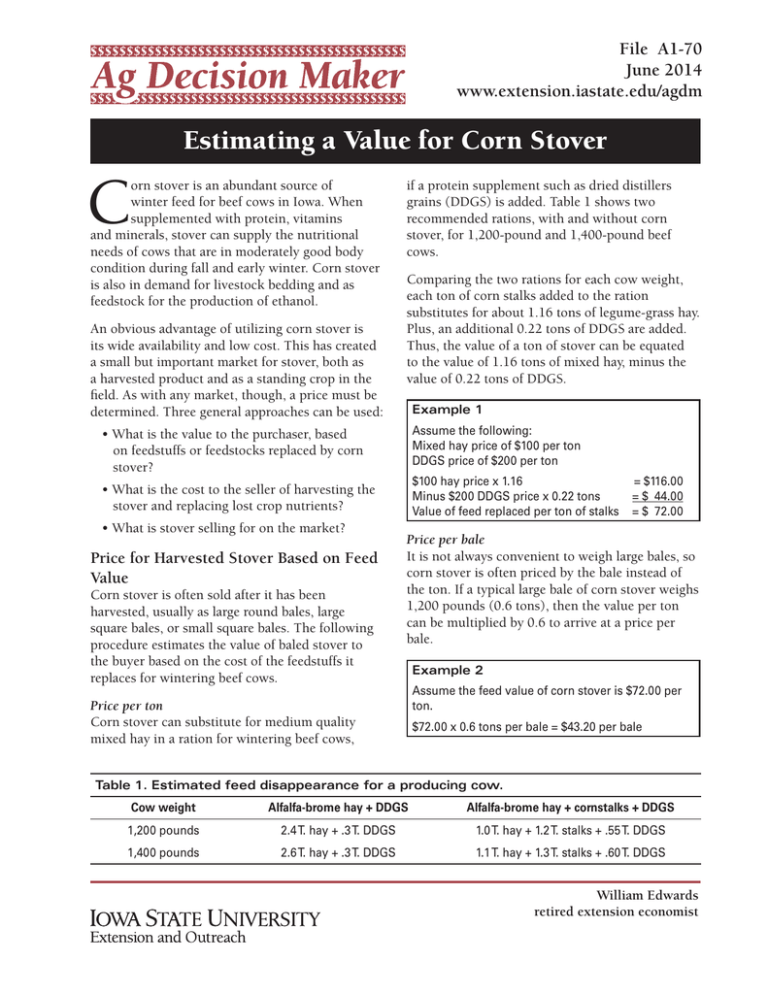
File A1-70 June 2014 www.extension.iastate.edu/agdm Estimating a Value for Corn Stover C orn stover is an abundant source of winter feed for beef cows in Iowa. When supplemented with protein, vitamins and minerals, stover can supply the nutritional needs of cows that are in moderately good body condition during fall and early winter. Corn stover is also in demand for livestock bedding and as feedstock for the production of ethanol. An obvious advantage of utilizing corn stover is its wide availability and low cost. This has created a small but important market for stover, both as a harvested product and as a standing crop in the field. As with any market, though, a price must be determined. Three general approaches can be used: if a protein supplement such as dried distillers grains (DDGS) is added. Table 1 shows two recommended rations, with and without corn stover, for 1,200-pound and 1,400-pound beef cows. Comparing the two rations for each cow weight, each ton of corn stalks added to the ration substitutes for about 1.16 tons of legume-grass hay. Plus, an additional 0.22 tons of DDGS are added. Thus, the value of a ton of stover can be equated to the value of 1.16 tons of mixed hay, minus the value of 0.22 tons of DDGS. Example 1 Assume the following: Mixed hay price of $100 per ton DDGS price of $200 per ton • What is the value to the purchaser, based on feedstuffs or feedstocks replaced by corn stover? $100 hay price x 1.16 = $116.00 Minus $200 DDGS price x 0.22 tons = $ 44.00 Value of feed replaced per ton of stalks = $ 72.00 • What is the cost to the seller of harvesting the stover and replacing lost crop nutrients? • What is stover selling for on the market? Price for Harvested Stover Based on Feed Value Corn stover is often sold after it has been harvested, usually as large round bales, large square bales, or small square bales. The following procedure estimates the value of baled stover to the buyer based on the cost of the feedstuffs it replaces for wintering beef cows. Price per bale It is not always convenient to weigh large bales, so corn stover is often priced by the bale instead of the ton. If a typical large bale of corn stover weighs 1,200 pounds (0.6 tons), then the value per ton can be multiplied by 0.6 to arrive at a price per bale. Price per ton Corn stover can substitute for medium quality mixed hay in a ration for wintering beef cows, Example 2 Assume the feed value of corn stover is $72.00 per ton. $72.00 x 0.6 tons per bale = $43.20 per bale Table 1. Estimated feed disappearance for a producing cow. Cow weight Alfalfa-brome hay + DDGS Alfalfa-brome hay + cornstalks + DDGS 1,200 pounds 2.4 T. hay + .3 T. DDGS 1.0 T. hay + 1.2 T. stalks + .55 T. DDGS 1,400 pounds 2.6 T. hay + .3 T. DDGS 1.1 T. hay + 1.3 T. stalks + .60 T. DDGS William Edwards retired extension economist Page 2 This value would have to be discounted by the cost to the cattle producer of transporting the bales to the site of the cattle. The weight of a bale will vary considerably depending on the type of baler used and the dryness of the stover. Large round corn stover bales typically contain about 8 to 10 pounds of dry matter per cubic foot. Using this factor, the weight in (wet) pounds of a large round bale of 20 percent moisture stalks can be estimated as follows: Weight (pounds) = diameter (inches) x diameter (inches) x width (inches) x .005 Example 3 Assume a large round bale measures 72 inches in diameter and 60 inches wide. 72 x 72 x 60 x .005 = 1,555 lb. per bale 1,555 pounds per bale ÷ 2,000 lb. per ton = .78 tons per bale Large square bales have been estimated to contain 10 to 12 pounds of stover per cubic foot. The wet weight of a 20 percent moisture square bale can be estimated as follows: Weight (pounds) = width (inches) x height (inches) x length (inches) x .008 Example 4 Assume a large square bale measures 3 feet wide by 4 feet high by 8 feet long (36 inches by 48 inches by 96 inches). 36 x 48 x 96 x .008 = 1,327 lb. per bale 1,327 lb. per bale ÷ 2,000 lb. per ton = .66 tons per bale Cost Value The costs for windrowing, baling, collecting and transporting corn stover can be estimated from typical farm custom rates such as those reported in File A3-10, Iowa Farm Custom Rate Survey. Chopping and raking are two alternatives for accumulating material into a windrow. If bales must be transported to the point of sale, that cost should be included, as well. Wrapping round bales with plastic netting instead of twine adds about $1 per bale to the total cost. File A1-70 Example 5 shows an estimate of total costs for harvesting and transporting large square bales based on custom rates. More details can be found in fact sheet PM 3053B, Economics of Harvesting and Transporting Corn Stover. Example 5 Custom hire machinery rates: Custom stalk chopping Assuming four bales/acre Custom baling Moving/collecting = $11.40 per acre = $ 2.85 per bale = $11.70 per bale = $ 3.55 per bale Total harvesting cost Transport to point of sale = $18.10 per bale = $ 6.25 per bale Total harvest + transport = $24.35 per bale (25 miles @ $.25/mile/bale) In addition, extra nutrients removed by harvesting must be replaced for future crops. Research results vary, but Sawyer and Darr have reported removal rates of about 2 to 4 pounds of phosphate and 8 to 20 pounds of potash per ton of dry matter stover harvested. If stover contains 80 percent dry matter, the removal rates are 1.6 to 3.2 pounds of phosphate and 6.4 to 16.0 pounds of potash per ton of wet stover harvested. These rates can vary widely depending on the hybrid planted, yields obtained, how much of the stover is harvested, and rainfall patterns. A forage laboratory test can be performed to find the specific analysis. Stover also contains some micronutrients, such as sulfur, that may need to be considered. The effect of harvesting stover on nitrogen fertilizer requirements is less certain. Some research shows that removing stover can actually increase the availability of nitrogen to the succeeding crop. The value of the nutrients being removed can be based on the cost of commercial fertilizer, as shown in Example 6. Replacement costs of $.53 per pound for P and $.50 per pound for K and removal rates of 2.64 lb. of P and 13.6 lb. of K per wet ton are assumed. Page 3 File A1-70 in order to assure they receive clean, dry material in timely fashion. Rates are usually set in advance by contract. Example 6 Assume the following: Weight of round bale is 1,200 lb. (.6 tons) Phosphate removal value = 2.64 lb. @ $.53 x .6 T. Potash removal value = 13.6 lb. @ $.50 x .6 T. Price for Unharvested Cornstalks =$ .84 =$ 4.08 Total value of nutrients removed per bale=$ 4.92 Total harvesting cost per bale = $24.35 Total cost per bale =$29.27 The total cost per bale represents the minimum amount the crop producer would be willing to accept, and the feed value represents the maximum the livestock producer would be willing to pay. The actual price paid may be negotiated somewhere within this range. In the examples above, the range would be from $29.27 to $43.20 per 1,200-pound bale. Feedstock for Ethanol Production Corn stover can also be used as a feedstock for the production of ethanol and other products. However, special care must be taken to avoid incorporating dirt, rocks and other foreign material into the bales. For stover to be suitable for conversion to biofuel, it must also be kept dry. This means that special harvesting and handling methods may have to be used, and extra costs will be incurred that must be factored into the market price. On the other hand, the value of corn stover to the processor will depend on the costs of operating the plant and the price of substitute feedstocks. Market Value Although market prices for harvested corn stover are not reported on a regular basis, bales are sometimes sold at hay auctions. Some auctions report prices on their websites, which can be located by searching on “hay auction.” Recent auction prices in Iowa for large round bales of corn stover have ranged from $30 to $40 per bale, with some sales as high as $45 per bale. Processers who wish to utilize corn stover for producing biofuels or other products generally will pay a higher price Some corn producers have stover to sell but do not have a baler. They may prefer to sell unharvested stover and let the buyer do the harvesting. The maximum net value to the buyer can be estimated as the feed value ($43.20) minus the cost of harvesting and transporting the bales ($24.35), or $18.85 per bale, as shown in Example 7. Example 7 Assume the following: Feed value of stover =$43.20 per bale (Example 2) Harvesting cost per bale=$24.35 per bale (Example 5) Feed value of standing stover to be harvested =$18.85 per bale The added cost to the corn producer would simply be the value of the nutrients removed. In Example 6, that was estimated at $4.92 per bale, so the range of values for negotiating a selling price would be $4.92 to $18.85 per bale harvested. Establishing a price based on the number of bales harvested is probably more accurate than establishing a price by the acre because it reflects the quantity of material actually removed. Price for Grazing Corn Stover Sometimes it is easier to bring the cows to the stover than it is to take the stover to the cows. If fences and water are adequate, stalk fields can simply be rented for grazing. Although rates vary widely, beef cows typically need about 2 acres per cow per month. Corn stover can replace about 25 pounds of hay equivalent per day for a medium-sized cow with no calf nursing, or .375 tons per month. If hay is priced at $100 per ton, the cost is $37.50 per cow per month, so each acre of stover grazed replaces $18.75 worth of hay. However, the person renting the stover may incur some costs for providing water or fencing, and for moving the cows to the field, which reduces the affordable rent. Page 4 Example 8 Assume 2 acres of corn stover replace 25 pounds of hay per day. 25 lbs. of hay/day x 30 days per month = 750 lbs. or .375 tons of hay per month .375 tons x $100 per ton/2 acres = $18.75 per acre File A1-70 Cash rental rates for grazing corn stover are reported in File C2-10, Cash Rental Rates for Iowa Survey. Typical rental rates are $8.00 to $12.00 per acre per year, or for as long as grazing is practical. An electronic spreadsheet, Decision Tool A1-70, Corn Stover Pricer, is available to estimate a price for corn stover harvested, unharvested in the field or grazed. Some phosphorus and potassium are removed when stalks are grazed, but part of it is returned in the form of animal waste. Cattle will generally remove less stover than is removed by baling. If cattle remove 1,500 pounds of stover during the grazing season, that is the equivalent of 1.25 bales. Based on nutrient removal costs of $4.92 per wet ton (Example 6), the removal cost per acre would be $6.15. However, many of these nutrients are returned to the land in the manure. Manure may need to be broken up and spread out using an implement such as a harrow after the grazing season is over. . . . and justice for all The U.S. Department of Agriculture (USDA) prohibits discrimination in all its programs and activities on the basis of race, color, national origin, gender, religion, age, disability, political beliefs, sexual orientation, and marital or family status. (Not all prohibited bases apply to all programs.) Many materials can be made available in alternative formats for ADA clients. To file a complaint of discrimination, write USDA, Office of Civil Rights, Room 326-W, Whitten Building, 14th and Independence Avenue, SW, Washington, DC 20250-9410 or call 202-720-5964. Issued in furtherance of Cooperative Extension work, Acts of May 8 and July 30, 1914, in cooperation with the U.S. Department of Agriculture. Cathann A. Kress, director, Cooperative Extension Service, Iowa State University of Science and Technology, Ames, Iowa.
